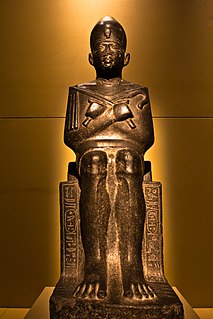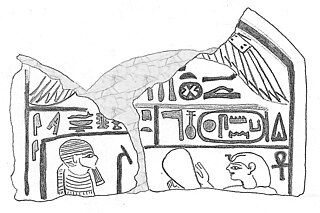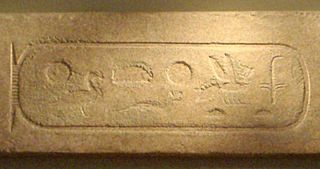
Merneferre Ay was an ancient Egyptian pharaoh of the mid 13th Dynasty. The longest reigning pharaoh of the 13th Dynasty, he ruled a likely fragmented Egypt for over 23 years in the early to mid 17th century BC. A pyramidion bearing his name shows that he possibly completed a pyramid, probably located in the necropolis of Memphis.

The Second Intermediate Period marks a period when Ancient Egypt fell into disarray for a second time, between the end of the Middle Kingdom and the start of the New Kingdom.
The Eighth Dynasty of ancient Egypt is a poorly known and short-lived line of pharaohs reigning in rapid succession in the early 22nd century BC, likely with their seat of power in Memphis. The Eighth Dynasty held sway at a time referred to as the very end of the Old Kingdom or the beginning of the First Intermediate Period. The power of the pharaohs was waning while that of the provincial governors, known as nomarchs, was very important, the Egyptian state having by then effectively turned into a feudal system. In spite of close relations between the Memphite kings and powerful nomarchs, notably in Coptos, the Eighth Dynasty was eventually overthrown by the nomarchs of Heracleopolis Magna, who founded the Ninth Dynasty. The Eighth Dynasty is sometimes combined with the preceding Seventh Dynasty, owing to the lack of archeological evidence for the latter which may be fictitious.

Sehetepkare Intef was the twenty-third king of the 13th dynasty during the Second intermediate period. Sehetepkare Intef reigned from Memphis for a short period, certainly less than 10 years, between 1759 BC and 1749 BC or c. 1710 BC.

Merhotepre Sobekhotep was an Egyptian king of the 13th Dynasty during the Second Intermediate Period. According to egyptologist Kim Ryholt he was the thirtieth pharaoh of the dynasty, while Darrell Baker believes instead that he was its twenty-ninth ruler. In older studies, Jürgen von Beckerath and Detlef Franke identified Merhotepre Sobekhotep with Merhotepre Ini, thereby making him Sobekhotep VI and the twenty-eighth ruler of the 13th dynasty.

Semenkare Nebnuni is a poorly attested pharaoh of the early 13th Dynasty during the Second Intermediate Period. According to Egyptologists Darrell Baker and Kim Ryholt, Nebnuni was the ninth ruler of the 13th dynasty. Alternatively, Jürgen von Beckerath and Detlef Franke see him as the eighth king of the dynasty.

Maaibre Sheshi was a ruler of areas of Egypt during the Second Intermediate Period. The dynasty, chronological position, duration and extent of his reign are uncertain and subject to ongoing debate. The difficulty of identification is mirrored by problems in determining events from the end of the Middle Kingdom to the arrival of the Hyksos in Egypt. Nonetheless, Sheshi is, in terms of the number of artifacts attributed to him, the best-attested king of the period spanning the end of the Middle Kingdom and the Second Intermediate period; roughly from c. 1800 BC until 1550 BC. Hundreds of scaraboid seals bearing his name have been found throughout Canaan, Egypt, Nubia, and as far away as Carthage, where some were still in use 1500 years after his death.
Sankhenre Sewadjtu was the thirty-fourth pharaoh of the 13th dynasty during the Second Intermediate Period. Sewadjtu reigned from Memphis, starting in 1675 BC and for a period of 3 years and 2 to 4 months.
Sewadjkare was an Egyptian pharaoh of the 13th Dynasty during the early Second Intermediate Period. According to egyptologists Kim Ryholt and Darrell Baker he was the eleventh ruler of the dynasty, reigning for a short time c. 1781 BC. Alternatively, Thomas Schneider, Detlef Franke and Jürgen von Beckerath see him as the tenth king of the 13th dynasty, with Schneider placing his reign at c. 1737 BC.

Sewahenre Senebmiu is a poorly attested Egyptian pharaoh of the late 13th dynasty during the Second Intermediate Period. According to egyptologist Jürgen von Beckerath, he was the forty-first king of the 13th dynasty. Alternatively, Darrell Baker proposes that he may have been its fifty-seventh ruler. Kim Ryholt only specifies that Senebmiu's short reign dates to between 1660 BC and 1649 BC.
Sewadjkare III was an Egyptian pharaoh of the 14th Dynasty of Egypt during the Second Intermediate Period c. 1700 BC. As a king of the 14th dynasty, Sewadjkare III would have reigned from Avaris over the eastern Nile Delta and possibly over the western Delta as well.

Merkheperre was an Egyptian pharaoh of the late 13th Dynasty of Egypt during the Second Intermediate Period reigning some time between 1663 BC and 1649 BC. As such Merkheperre would have reigned either over Upper Egypt from Thebes or over Middle and Upper Egypt from Memphis. At the time, the Eastern Nile Delta was under the domination of the 14th Dynasty.
Merkare was an Egyptian pharaoh of the late 13th Dynasty of Egypt during the Second Intermediate Period reigning for a short while, some time between 1663 BC and 1649 BC.

Djedkheperew was an Egyptian pharaoh of the 13th Dynasty reigning for an estimated two-year period, from c. 1772 BC until 1770 BC. According to Egyptologists Kim Ryholt and Darrell Baker, Djedkheperew was the 17th king of this dynasty. Djedkheperew is this pharaoh's Horus name; the prenomen and nomen of Djedkheperew, which would normally be employed by modern conventions to name a pharaoh, are unknown.

Sekheperenre was an Egyptian pharaoh of the 14th Dynasty of Egypt during the Second Intermediate Period. According to the egyptologists Kim Ryholt and Darrell Baker, Sekheperenre was the twenty-second king of the dynasty; alternatively, Jürgen von Beckerath sees him as the seventeenth ruler. As a king of the 14th dynasty, Sekheperenre would have reigned from Avaris over the eastern Nile Delta and possibly over the western Delta as well.
Sehebre was a ruler of the 14th Dynasty of Egypt ruling for 3 to 4 years c. 1700 BC during the Second Intermediate Period. According to egyptologists Kim Ryholt, Jürgen von Beckerath and Darrell Baker, he was the 5th king of the dynasty. As such he would have ruled from Avaris over the eastern Nile Delta and possibly over the Western Delta as well.
Bebnum is a poorly known ruler of Lower Egypt during the Second Intermediate Period, reigning in the early or mid 17th century BC.

Nebsenre was an Egyptian pharaoh of the 14th Dynasty of Egypt during the Second Intermediate Period. Nebsenre reigned for a least five months over the Eastern and possibly Western Nile Delta, some time during the first half of the 17th century BCE. As such Nebsenre was a contemporary of the Memphis based 13th Dynasty.
















